Interview
Black History Month: Caribe’s Keshia Sakarah on celebrating the history of Caribbean food
25 Oct 2022
7m
As a second generation Caribbean living in London, Keshia Sakarah has always used food as a means of connecting to her roots.
“Having this duality in my own identity, where I was born and raised in England but being of Caribbean (Montserrat and Barbuda) heritage, food was always the way consistently throughout my life that I was able to connect with [that side of myself],” the founder of Caribbean restaurant Caribe’ and supperclub, Baruru, tells Twisted.
Keshia did this not only by learning traditional Caribbean recipes, initially from her grandparents, but also by working with historians and researching the stories or ingredients behind the dishes from across the region – something she continues today in her popups and her upcoming cookbook, ‘Caribe’: A Cookbook with History.
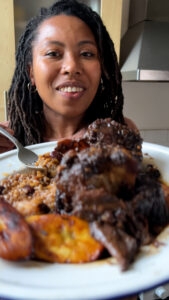
Keshia Sakarah speaks to Twisted for Black History Month (Credit: Twisted)
“I think I just started to approach my cooking and my work with a real kind of conscious responsibility, and realised that if I was going to cook something, I needed to understand where it’s from, and why it’s done that way,” she says.
There are over 44.2 million people living in the Caribbean, and as a result of colonisation and the region’s dark history of enslavement by European nations, the food eaten is infused with influences from indigenous Arawaks, West Africans, Indians, the British, and the Spanish.
“Because of the effects of colonialism, our place in society and our histories, a lot of [the backstories of Caribbean foodways] were never recorded in the ways that they should have been,” Keshia adds.
When cooking without being conscious or respectful of the origin of a dish, “you erase the foodways of people and the communities they belong to”.
With this in mind, we’ve dug into the history of three Caribbean dishes and their fascinating backstories, which should be remembered this Black History Month, and far beyond.
Jerk
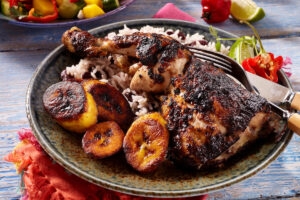
Jerk has a fascinating backstory (Credit: Alamy)
Perhaps one of the dishes most synonymous with Caribbean cookery around the world, jerk’s origin is the perfect example of how important food can be as a vessel for remembering generations gone by.
In fact Jamaican literary scholar, Carolyn Cooper, previously described it as “one of the enduring legacies of the fusion of African and Taíno cultures in Jamaica.”
To give some context, a war between the British and the Spanish for control of Jamaica, during the 17th century, “created an opportunity for those enslaved by the Spanish to flee,” Keshia explains.
“They were called the ‘maroons’ because they lived and hid in the depths of the mountains to evade capture by colonists. It is said thousands populated small settlements alongside the remaining Taínos on the island.”
The indigenous Taínos were a community who inhabited the land as far back as 800AD, but tragically, they were mostly wiped out by Spain’s initial colonisation of the land (formerly named Xamayca).
When the Spanish ruled between 1494–1655, only ten percent of the Taíno population survived, as the vast majority were persecuted for their land and produce.
However, those that had survived did so off the land, hunting and preserving meat which they called charqui (or jerky) – believed to be where the cooking methods and seasoning of jerk originates.
“The indigenous people were well versed on the land they had inhabited for so long. They knew how to survive on what was accessible to them, and so they taught [the maroons] some of these techniques,” Keshia says.
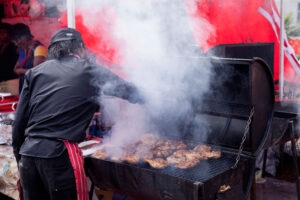
Good jerk is still cooked with similar flavours today (Credit: Alamy)
With the Taíno culinary habits adopted, the maroons then undertook the art of underground cooking, which stopped their enemies from detecting them.
“They would roast wild boars on pimento wood in holes in the ground, covered with loads of greenery, like banana leaves, to hide the smoke released from the fire.” Keshia adds. “This was done purely for survival and to avoid capture.
“That’s why jerk has a very particular flavour when it’s done right”.
Today, the meat is typically marinated in a wet or dry rub using pimento seeds, to honour the original warm, smoky flavours, as well as scotch bonnet peppers, onions, thyme and garlic.
Whilst pork was the original and still is the most popular meat, jerk is now also made with other meats like chicken, and enjoyed as a delicacy instead of just a necessary means of sustenance.
Given that it started off as a dish born out of resistance, it’s amazing to think that now, jerk is all over the island (and, indeed, the rest of the world).
As renowned BBQ chef Gariel Ferguson puts it: “Jerk is freedom manifested in food.”
Oxtail Stew

Stewed oxtail is steeped in history (Credit: Twisted)
The history of oxtail is also linked to the colonisation of the Caribbean.
“When the Europeans colonised the Caribbean (in 1494), they took over things like livestock. So for example, cows and chickens weren’t indigenous to this place at all,” Keshia explains.
This is because the Europeans who settled brought animals and produce from the so-called ‘Old World’ (Afro-Eurasia) along with them when they overtook the land, so they could eat the foods they were accustomed to.
The people they enslaved – largely brought over from West Africa – weren’t offered the same cuts, and instead had to make do with the sparse leftovers of their captors’ meals.
“In servitude, it’s said that a lot of the ingredients that were used in dishes were minimal,” Keshia adds. “They’d be left with things that most of us would consider offal or the less desired cuts of meat”.
This is where oxtail – literally the tail of an ox – was first used in cookery.
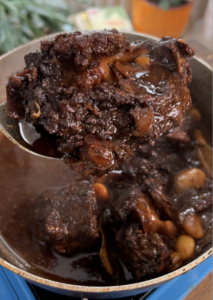
Stewed oxtail is typically slow cooked for hours (Credit: Twisted)
The sheer span of the ingredients in the dish today is a prime example of how food can reflect the history of a region and its people. In fact, it is cooked in a variety of ways across the Caribbean, as different areas depended on different accessible ingredients.
A typical Jamaican recipe sees the meat seasoned with the likes of pimento (also known as allspice, a Taíno indigenous plant), thyme (brought to Jamaica by the Spanish) and soy sauce (Chinese, and “brought over in the early 1800s, following the abolition of slavery, and their introduction to the region as indentured workers”).
Sugar (a product of the transatlantic slave trade) Scotch bonnet peppers (brought over by explorers of the Antilles, and later the Taino, from the western Amazon basin) and ginger (brought to the region by the Spanish), are also commonly found in oxtail stew.
Whilst ingredients may have varied from area to area, on plantations across the Caribbean, it was common to see cooking in cast iron dutch pots over an open fire, which is a key reason oxtail is slow cooked today.
“[At the time] this was due to accessibility, as there weren’t proper kitchens designed for those enslaved to cook,” says Keshia.
Food was typically eaten communally, too – something which is still a huge part of Caribbean food culture, and another powerful example of the way that history has informed it.
“This [communal cooking and eating of oxtail] was an example of the many elements of West African culture that were preserved and leaned on through food for survival,” Keshia says.
Pastelitos de Guayaba y Queso

Keshia’s Pastelitos de Guayaba y Queso (Credit: Twisted)
Pastelitos de guayaba y queso hail from Cuba, and the little pastries made from guava jam and cheese are Caribbean delicacies with a very interesting backstory.
Like stewed oxtail, this snack is demonstrative of the many influences that make up Caribbean food culture in the islands and across the diaspora today.
“Originally, this recipe would be made exclusively from guava paste (also known as guava cheese) – a jam made from fresh guavas,” says Keshia.
Guavas are abundant across the Caribbean (also likely a product of Spanish colonisation, as their seeds originate from Central America and Mexico), and are subsequently a key ingredient within the region’s cuisine.
“However, the addition of cream cheese is said to have been influenced by the American expansion into Cuba as a result of the Spanish/ American war [over colonialism].”
Because the US won the war with the Spanish, they were involved in Cuban society – politically and culturally – until the Communist Revolution of 1959.
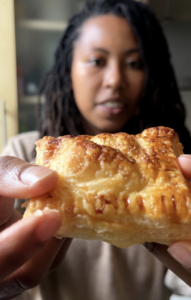
Pastelitos de Guayaba y Queso is filled with guava and cheese (Credit: Twisted)
Subsequently, many Cubans discovered American products like Philadelphia Cream Cheese during this time, and that’s how it became part of the snack we know today.
First came cheese pastelitos, according to food writer and chef, Carlos C Olaechea. Then, the combination of the two flavours arose following Fidel Castro’s takeover of Miami, when Cubans started to move there and set up bakeries.
Olaechea adds that it was likely a “Miami Cuban baker” that mixed guava and cream cheese together in a pastry for the first time, although “salty uncultured cheese—called queso fresco or queso blanco—with slices of congealed guava paste [has been enjoyed by Cubans] for as long as they have been making guava paste and cheese”.
“Now, these pastries can be found in bakeries across Little Havana, where the Cuban diaspora live in Miami,” Keshia explains. Today, they are filled with various semi-soft cheeses and not just cream cheese.
Despite what we may know about the origins of the pastelitos de guayaba y queso, the history of when pastelitos were first cooked is slightly murkier.
Some historians say that the dish was created by enslaved people working in Spanish and Cuban sugar mills, whilst others attribute the dish to Cuban households, where it is believed to have been served as an appetiser or a side dish alongside a main meal.
“There is also a theory that [the dish came from] Lebanese immigrants trying to recreate baklava,” Keshia adds.
Like with many popular dishes, pastelitos are claimed by many today, but there’s no denying they’re a dish entrenched in Cuban history.
You can find recipes for Keshia’s pastelitos de guayaba y queso and Jamaican stewed oxtail on Twisted, and her book, ‘Caribe’: A Cookbook with History, is due for release May 2024 by Hardie Grant publishing.

.jpg_RVG9qi?tr=w-2560,f-webp,q-70)
.png_2XIXGj?tr=w-2560,f-webp,q-70)
.jpg_qa3BF9?tr=w-2560,f-webp,q-70)